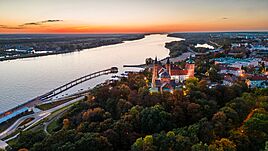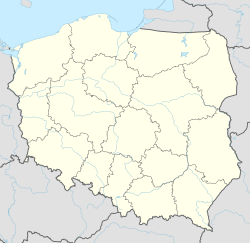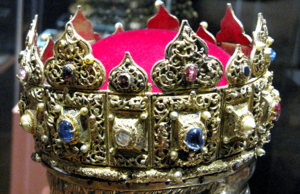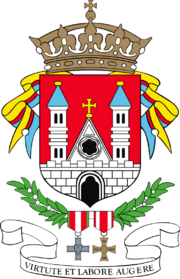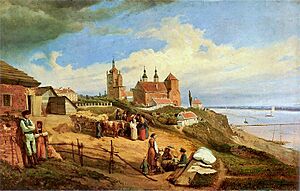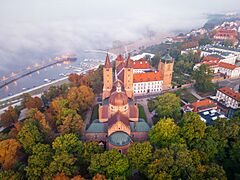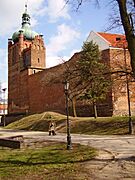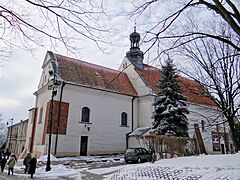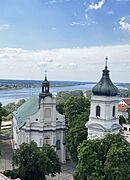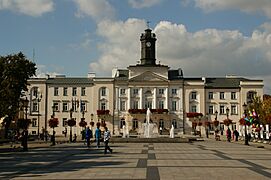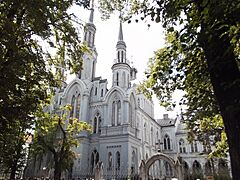Płock facts for kids
Quick facts for kids
Płock
|
|||
|---|---|---|---|
| Stołeczne Książęce Miasto Płock Ducal Capital City of Płock |
|||
|
|||
|
|||
| Motto(s):
Virtute et labore augere
|
|||
| Country | |||
| Voivodeship | |||
| County | city county | ||
| Established | 10th century | ||
| City rights | 1237 | ||
| Area | |||
| • Total | 88.06 km2 (34.00 sq mi) | ||
| Elevation | 60 m (200 ft) | ||
| Population | |||
| • Total | 116,962 |
||
| Time zone | UTC+1 (CET) | ||
| • Summer (DST) | UTC+2 (CEST) | ||
| Postal code |
09-400 to 09-411, 09-419 to 09-421
|
||
| Area code(s) | +48 24 | ||
| Car plates | WP | ||
| Website | Płock City Hall | ||
Płock (pronounced Pwot-sk) is a city in central Poland. It is located on the Vistula river in the Masovian Voivodeship. As of December 2021, about 117,000 people live there. Its full official name is Stołeczne Książęce Miasto Płock, which means "Princely Capital City of Płock". This name is used for special documents and to keep an old tradition alive.
Płock is the main city of a county in western Masovian Voivodeship. From 1079 to 1138, it was the capital of Poland. The area called Wzgórze Tumskie (Cathedral Hill) is very important. It has the Płock Castle and the Catholic Cathedral. The cathedral holds the tombs of several Polish monarchs. This area is listed as a Historic Monument of Poland.
Płock was a major city in Mazovia during the Middle Ages. It was important before Warsaw grew bigger. It is a center for culture, learning, science, and transport in its region. Płock is also home to the Roman Catholic Diocese of Płock, one of Poland's oldest religious areas. It is also the main worldwide center for the Mariavite Church. The Marshal Stanisław Małachowski High School in Płock is the oldest school in Poland. The Płock refinery, Poland's largest oil refinery, is also located here.
Contents
History of Płock
Early Times and Middle Ages
Long ago, early communities lived in the Płock area. In the 10th century, a strong fort was built high on the Vistula River bank. This spot was great for shipping and trade routes. It was important for many centuries. In 1009, a Benedictine monastery was built here. It became a center for learning and art.
Płock was a royal home for early Polish rulers. This was even before Poland became Christian. Prince Mieszko I and King Bolesław I the Brave lived here. The king built the first strong walls on Cathedral Hill. This hill overlooks the Vistula River. From 1037 to 1047, Płock was the capital of a separate state called Mazovia. Many Mazovian princes lived in Płock.
In 1075, a Catholic church area was created here. From 1079 to 1138, Płock was the capital of Poland. This was during the rule of Władysław I Herman and Bolesław III Wrymouth. This is how it got its name, "Princely Capital City of Płock." After Poland split into smaller areas, Płock became the capital of the Duchy of Masovia. Later, it was the capital of the Duchy of Płock.
In 1180, the Marshal Stanisław Małachowski High School was founded. It is the oldest school still open in Poland. It is also one of the oldest in Central Europe. A famous student was Paweł Włodkowic. He was a scholar who supported religious freedom in Europe.

In 1237, Płock officially became a town. Its town rights were confirmed again in 1255. Płock was on an important trade route. This route connected Toruń with Warsaw and other cities. In the 14th century, King Casimir III the Great gave Płock many special rights. The first Jewish people came to the city in the 14th century. They came because Polish kings offered them more rights. In 1495, the Duchy of Płock became part of the Polish Crown.
Modern Era and Challenges
In later times, Płock was a royal city of Poland. It was the capital of the Płock Voivodeship. The 16th century was a great time for the city. But then, Płock lost many people due to diseases, fires, and wars. This happened during the Polish–Swedish wars in the late 17th and early 18th centuries.
In the 17th century, Swedish armies destroyed much of the city. But the people rebuilt Płock. In the late 18th century, the old city walls were taken down. A new part of the city was built. After Poland was divided in 1793, Płock became part of Prussia. Many German people moved to Płock then.
From 1807, Płock was part of the Duchy of Warsaw. This was a short-lived Polish state. In 1815, it became part of Congress Poland. Later, it was fully taken over by the Russian Empire. The Polish 3rd Rifle Regiment was in Płock. This regiment later fought against Russia. In 1827, Fryderyk Chopin, a famous composer, visited Płock. In 1831, the last Polish parliament meeting was held in the Płock town hall.
Płock was an important center for government and trade. It had a new city plan in the early 1800s. Many beautiful buildings were built in the Neoclassical style. In 1820, the Płock Scientific Society was started. In the late 1800s, the city began to have more factories. In 1863, local Poles fought against Russia in the January Uprising. The leader of this uprising in Płock, Zygmunt Padlewski, was killed by the Russians in May 1863. In 1905, many Polish young people and workers held protests in Płock.
During World War I, Germany took over Płock from 1915 to 1918. In 1918, Poland became independent again. Płock was immediately part of Poland once more. In August 1920, the city became famous for bravely defending itself against Soviet forces. This was during the Polish–Soviet War. About 250 Polish defenders, including 100 regular people, died in the battle. In 1921, Marshal Józef Piłsudski visited Płock. He gave the city the Cross of Valour. Płock was only the second Polish city to get such a military award.
World War II and Beyond

When Germany invaded Poland in September 1939, Płock was taken over by Germany. The Germans renamed the city Schröttersburg in 1941.
The Germans arrested many Polish people. About 200 of them were sadly killed in massacres nearby. These victims included teachers, activists, and local officials. The Archbishop of Płock, Antoni Julian Nowowiejski, and Bishop Leon Wetmański were arrested. They were later killed in a camp in 1941. They are now honored as two of the 108 Blessed Polish Martyrs of World War II.
Many Poles were forced to leave their homes. Over 1,300 Poles were expelled in late 1939. More than 4,000 were expelled in early 1941. The Germans also forced people to work without pay. Even children aged 10 to 14 were forced to work. Older children were sent to Germany for forced labor. The Germans also ran forced labor camps in the city. In the winter of 1942–1943, a train with kidnapped Polish children arrived. About 300 of these children sadly froze to death. They were buried by the Germans in nearby forests. From 1943, Poles, including teenage boys, were sent to the Stutthof concentration camp.
The Nazis also treated the Jewish people of Płock very badly. They forced them to work and created a Jewish ghetto in 1940. Up to ten people shared each room in the ghetto. There was not enough medicine, and diseases spread. Many Jewish people were killed in Płock. Most were sent to other areas and then to Treblinka to be murdered. By the end of the war, only about 300 Jewish residents survived. Before the war, there were more than 10,000 Jewish people in the region. Some Poles in Płock tried to help their Jewish neighbors. They smuggled food into the ghetto and gave food to them when they were waiting to be sent away. These were small acts, but they took great courage.
The Germans closed Polish schools and newspapers. They also stole or destroyed many Polish cultural treasures. This included the collections of museums and church archives. The local seminary (a school for priests) was turned into army barracks by the Germans.
Despite these hard times, Płock remained a center for the Polish underground resistance. Secret Polish schooling was organized. In September 1942, the Germans publicly killed 13 Polish resistance members in the Old Town. On January 19, 1945, the German secret police killed 79 Poles. They were either shot or burned alive. The city was returned to Poland. However, a new government put in place by the Soviet Union ruled until the 1980s.
In 1975–1998, Płock was the capital of the Płock Voivodeship. In 1976, Płock was a place of large protests against the communist government.
Climate
Płock has a climate with warm summers and cold winters. The average temperature in January is about -1.4°C (29.5°F). In July, the average temperature is about 19.0°C (66.2°F). The city gets about 450 millimeters (17.7 inches) of rain each year.
Culture and Places to See
Architecture
Płock has many interesting buildings. Here are some of the main sights:
- Płock Cathedral - This church was first built in the 12th century. It was rebuilt in the 16th century.
- Płock Castle - Built in the 14th century, it now holds a museum.
- Saint Dominic Church - This church was built in the 13th century and changed in the 16th century.
- Saint Bartholomew Church - Built in the 14th century, it was rebuilt in the 18th century.
- Small Synagogue - This Jewish place of worship was built between 1810 and 1822.
- Płock Town Hall - Built from 1824 to 1827 in a classic style.
- Temple of Mercy and Charity - This is the main church for the Mariavite Church. It was built from 1911 to 1914.
- Museum of Mazovia - This museum is in a beautiful old house.
- Dom Turysty - A modern hotel built from 1959 to 1962.
Museums
- Diocesan Museum - Located in the Płock Castle.
- Museum of Masovia - Shows the history of the city and region.
- The Museum of Mazovian Jews - Located in the old Small Synagogue.
- Saint Faustina Museum - A museum about Saint Faustina Kowalska.
- Małachowianka Museum - A museum about the Marshal Stanisław Małachowski High School.
Local Food
Płock has some special traditional foods. These include kiełbasa tumska, a type of kiełbasa (sausage) named after Cathedral Hill. Another is baleron płocki, a local type of baleron (smoked lunch meat).
Religion
Catholic Church
Płock is home to one of Poland's oldest Catholic dioceses. The Masovian Blessed Virgin Mary Cathedral was built here in the 12th century. It holds the tombs of Polish kings. It is one of the five oldest cathedrals in Poland.
The city is also known for the Divine Mercy Sanctuary. This is where Saint Faustina Kowalska said Jesus appeared to her. The Divine Mercy prayer was revealed here.
Mariavite Church
The Mariavite order of priests started from the visions of Feliksa Kozłowska in 1893. They wanted to improve the Catholic clergy. But the Vatican did not recognize them. So, in the early 20th century, they formed their own church. Płock is the main center for the Mariavite bishops. Their most important church, the Temple of Mercy and Charity, was built here. It is located in a nice garden on a hill near the Vistula River.
Jewish History
Jewish people have lived in Płock for many centuries. Records show them here as early as the 13th and 14th centuries. Polish kings gave them special rights. In the early 1800s, over 1,200 Jewish people lived in the Old Town. This was more than 48% of the city's population. They had two synagogues and two cemeteries. They also had schools, a library, and a hospital. They helped the city's economy and culture.
In 1939, Płock had about 9,000 Jewish residents. This was about 26% of the city. After Germany invaded Poland in 1939, the Nazis began to persecute Jewish people. About 2,000 Jews left the city. In 1940, the Nazis created a ghetto in Płock. They killed many Jewish people. Most were sent to other places and then to Treblinka to be murdered. By 1946, only about 300 Jewish people from Płock had survived.
The small synagogue, built in 1810, was one of the few to survive World War II in the region. The Great Synagogue was destroyed. The small synagogue was later renovated. In April 2013, it opened as the Museum of Masovian Jews.
Economy
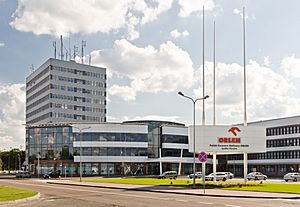
The main industry in Płock is oil refining. This started in 1960. The country's largest oil refinery (Płock refinery) and its main company, Orlen, are here. A large pipeline brings oil from Russia to Germany through Płock. Other jobs related to the refinery include maintenance and construction. A Levi Strauss & Co. factory is also in Płock, making clothes.
Education
Płock has several schools and universities:
- Szkoła Wyższa im. Pawła Włodkowica
- Akademia Mazowiecka w Płocku
- Płock Campus of Warsaw University of Technology
- LO im. Marszałka Stanisława Małachowskiego w Płocku - the oldest school in Poland, founded in 1180
- LO im. Wladysława Jagiełły w Płocku
- III LO im. Marii Dąbrowskiej w Płocku
- IV LO im. Bolesława Krzywoustego w Płocku
- Zespół szkół centrum edukacji im. Ignacego Łukasiewicza w Płocku
Transport
Mass Transit
KM Płock provides bus service throughout the city. There are 41 bus routes.
Bridges
- Pilsudskiego Bridge
- Solidarity Bridge
Sports
- Wisła Płock – This is one of Poland's best handball teams. They play in the top league and have won many Polish championships and cups.
- Wisła Płock – This is a football (soccer) team. They currently play in Poland's second division. They won the Polish Cup and Polish SuperCup in 2006.
Famous People from Płock
- Bolesław III Wrymouth (1086–1138), a Duke of Poland.
- Edward Flatau (1868–1932), a famous doctor who studied the brain.
- Władysław Broniewski (1897–1962), a poet and soldier.
- Stefan Themerson (1910–1988), a writer of children's literature and novels.
- Tadeusz Mazowiecki (1927–2013), a journalist and politician. He was the first non-communist Polish prime minister after 1946.
- Szymon Marciniak (born 1981), a well-known football referee.
- Bartosz Kwolek (born 1997), a volleyball player who won the World Championship in 2018.
Sister Cities
Płock has many sister cities around the world. This means they have special friendly relationships.
Płock used to be twinned with:
In March 2022, Płock stopped its partnerships with the Russian city of Mytishchi and the Belarusian city of Novopolotsk. This was because of the 2022 Russian invasion of Ukraine.
Images for kids
-
The bridge at Płock, destroyed by retreating Polish forces during the invasion of Poland in September 1939
-
Orlen headquarters
See also
 In Spanish: Płock para niños
In Spanish: Płock para niños


